When you explore the ocean from the surface level all the way down to the dark and mysterious depths, you discover creatures of wonder and awe-striking beauty. The sea is so vast that scientists believe there are still tons of undiscovered creatures.
Luckily, we do know a lot about many fish in the sea, and tons of them boast impressive camouflage capabilities that help them survive and thrive in unpredictable and often life-threatening habitats.
From textured scales to all the colors of the rainbow, our top ten favorite fish that camouflage will captivate you and make you want to learn more.
(You might be interested in reading about the Largest Fish in the Ocean)
Everything you will learn here
- Top 10 Fish That Camouflage
- 10. Fish That Camouflage: Reef Stonefish
- 9. Fish That Camouflage: Leaf Scorpionfish
- 8. Fish That Can Camouflage: Trumpetfish
- 7. Fish That Can Camouflage: Cuttlefish
- 6. Fish With Camouflage: Crocodile Fish
- 5. Fish With Camouflage: Leafy Seadragon
- 4. Fish With Camouflage: Tasseled Anglerfish
- 3. The Flatfish is a Fish that Can Camouflage In The Sand
- 2. Camouflaged “fish”: Pygmy Seahorse
- 1. Best camouflaged sea creature: Mimic Octopus
- A Couple More Masters of Disguise Worth Mentioning
Top 10 Fish That Camouflage
Learn how some of the sneakiest fish of the sea protect themselves by blending into their environments and sliding past predators. Our list consists of ten masters of camouflage that hide by changing colors, staying still, burying themselves, and more. We hope you enjoy our list, and it solves the quest on “What fish can camouflage?”.
10. Fish That Camouflage: Reef Stonefish
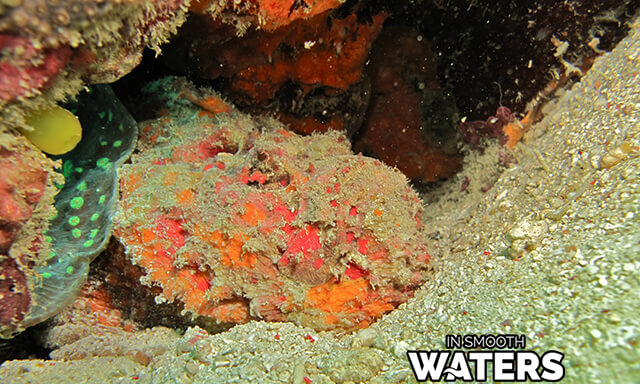
If there was a winner for the ugliest fish on the list, the reef stonefish would probably dominate in first place. However, it gets extra points for its incredible ability to camouflage itself in the ocean.
This guy might not be quite the looker, but its colorful exterior does a phenomenal job blending him into the ocean floor. The colors, along with the texture of its skin, make the fish look like a rock or even a lump of coral covered in sand and oceanic crust.
When other fish and sea creatures swim by, they simply don’t notice the stonefish. That is until it injects them with deadly poison from its 13 dorsal fin spines.
Not only is this fish a master of the camouflaged hunt, but it is known to be the deadliest fish in the world, to both its prey and to humans who are unlucky enough to encounter it.
9. Fish That Camouflage: Leaf Scorpionfish

The leaf scorpionfish, also referred to as the paper fish, varies in color from blue and red to yellow and tan. It’s a fairly aggressive, venomous fish, though it’s only about four inches in size.
The secret in that leaf scorpionfish’s camouflage is not simply that it looks like a leaf from a tree, but that it acts like one as well. Rather than swimming across the ocean, this fish often lets its body go limp so that it will move and swirl with the current.
The natural movements look so similar to a regular leaf floating in the water that prey doesn’t suspect a thing – until the fish makes its move and injects its deadly venom.
8. Fish That Can Camouflage: Trumpetfish
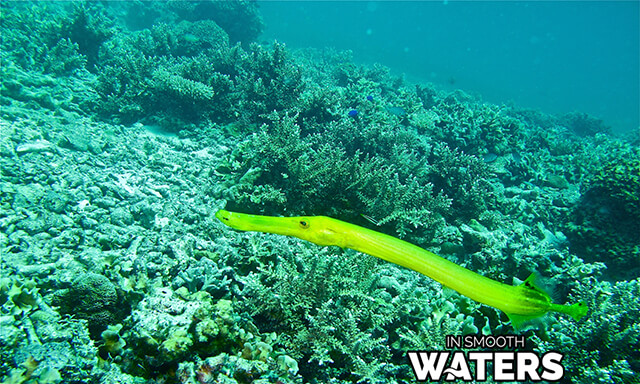
Trumpetfish differ from your average fish in the shape of its body. The long, narrow fish can grow anywhere from 24 to 36 inches, and it features a long, thin mouth that quickly sucks in food.
A master hider, the trumpetfish, blends into its surroundings by changing the color of its scales quickly to match coral. It then floats headfirst into the coral, making itself look just like it so it can wait and feed on unknowing prey.
The trumpetfish is so good at hiding that it sometimes even uses large herbivorous fish, swimming along the side of them as their own personal shadow until it comes across its dinner. Its thin body is also perfect for drifting along with the current, sucking it prey as it goes along.
7. Fish That Can Camouflage: Cuttlefish
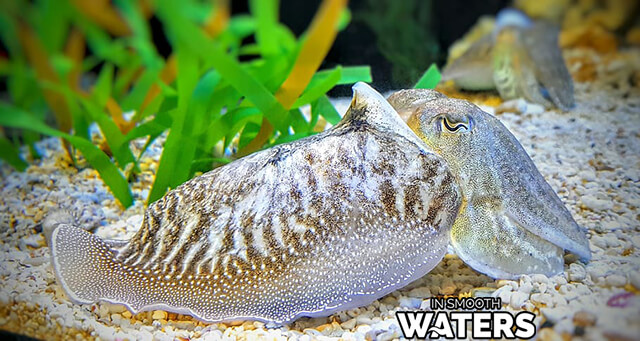
Though you might not guess it by its name, the cuttlefish is actually closely related to octopuses and squids. This interesting-looking fish hides easily by changing the color of its skin to match whatever its surroundings happen to be.
This undersea chameleon can also shift the shape of its body, helping it disguise itself as various ocean objects like coral, algae, and the sandy floor. In other words, it changes to match the things that predators don’t care about.
Perhaps the most impressive part about this little fish is that its skin has approximately ten million color cells. Scientists compare these cells to the likes of high-definition television, and even the military has studied the animal in their development of camouflage for soldiers.
6. Fish With Camouflage: Crocodile Fish
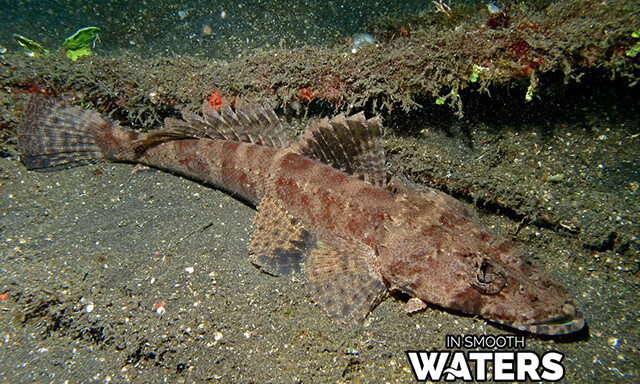
Crocodile fish received their name due to their uncanny resemblance to actual crocodiles. Not only does their appearance make them look terrifying to humans who associate them with their ferocious models, but it’s highly helpful in hiding them from their prey and predators.
The sandy color and marking of the crocodile fish allow them to blend in with the ocean floor, encompassing the dirt, rocks, pebbles, and plants.
This isn’t dissimilar from many other fish, but the crocodile fish does have one extra feature that helps them blend in just a little more.
This fish has pieces of skin called Lappets that cover their eyes in fragments. The skin serves to break up the black color of their large eyes, which are the only thing that reveals them when they’re camouflaged to the ocean floor.
5. Fish With Camouflage: Leafy Seadragon
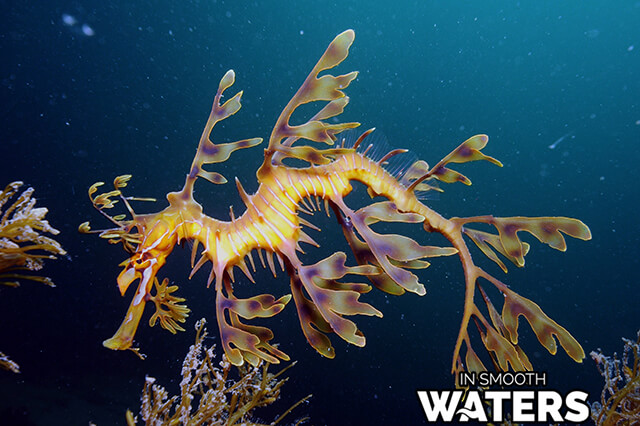
The name makes this sea creature sound like something from a movie, but there’s nothing mythical about it. The leafy seadragon is a highly unique and strangely beautiful ocean animal closely related to seahorses.
Their yellow-brown coloring paired with their green appendages closely match the color of seaweed; however, it’s their shape that gives them the ultimate camouflage advantage.
Rather than boasting typical fins, the leafy seadragon lives up to its name with its leaf-shaped fins. It looks as though this animal attached a bunch of seaweed to its body, but that’s just how its body looks.
The leafy fins are simply for visual appeal, letting the fish hide among the seaweed undetected. The leafy seadragon has two specific fins used for swimming, but they’re so thin that you can barely see them.
4. Fish With Camouflage: Tasseled Anglerfish
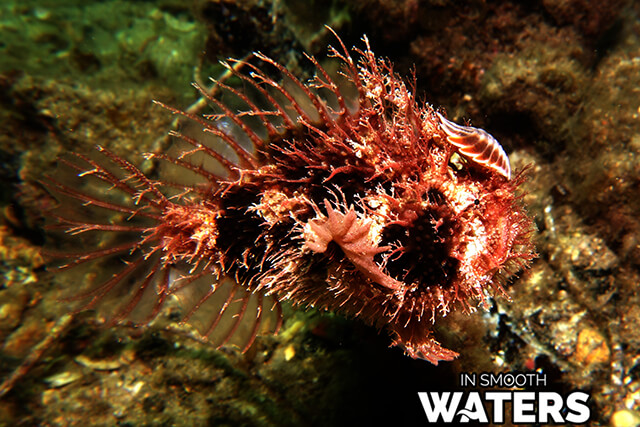
Some call the tasseled anglerfish the master of disguise in the sea, while its name reveals its other strength: fishing for fish.
While camouflage is often used for protection – and the tasseled anglerfish certainly uses its ability for this – it also comes in handy right around dinner time.
When hidden among the coral, sponge, and seaweed in the ocean, this anglerfish is all but completely invisible. Its secret lies in the bumps, warts, and fleshy skin that look exactly like its surroundings. The texture of this fish’s body perfectly reflects the seaweed and such around it, until the only thing you might be able to see is its eyeball.
Once in hiding, the tasseled anglerfish dangles a lure-like feature that has something on the end that looks similar to a worm. Its prey can’t see the fish, but they don’t miss the delicious-looking lure.
3. The Flatfish is a Fish that Can Camouflage In The Sand
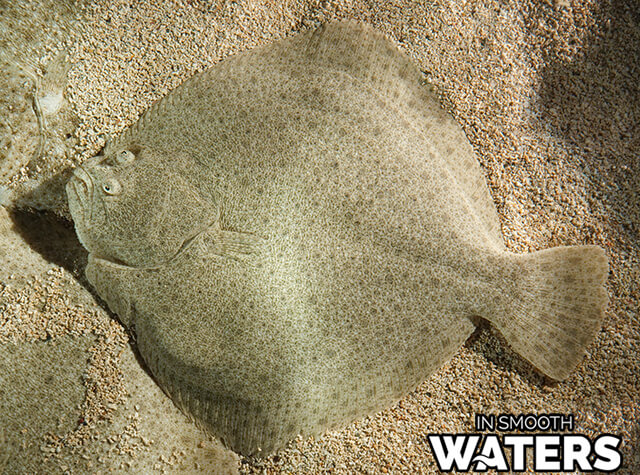
The flatfish, though not the prettiest fish of the sea, is certainly a master of camouflage. Deep in the depths of the ocean, the flatfish uses its natural abilities to hide on the seafloor. As its name suggests, the fish is wide yet very thin, allowing it to settle flat to the ground, practically unnoticed.
In addition, these fish can change the color of their scales to match the gritty, stone-riddled texture of the ocean floor. When they lay flat, it’s almost impossible to see them. They also sometimes bury themselves with sand and pebbles, causing their enemies to swim right past them without a second glance. The fish is master that can camouflage in the sand and other ocean grounds.
2. Camouflaged “fish”: Pygmy Seahorse

If you’ve ever seen a seahorse, you know that they are tiny, fragile sea creatures that do a good job showcasing their name’s sake: a horse. Though their minuscule size makes them difficult to spot, they don’t really have any natural form of self-defense against predators aside from their camouflage capabilities.
The specific breed of seahorse, the pygmy seahorse, possesses little tubercles all across its body that transform to mimic the colors and shape of the coral that the creature resides in. The pygmy seahorse lives in the gorgonian coral.
To match this kind of coral, a pygmy seahorse will either be purple with pink tubercles or yellow with orange tubercles. Not only are these colors essential for this animal’s survival, but they make for excellent marine life photography.
1. Best camouflaged sea creature: Mimic Octopus
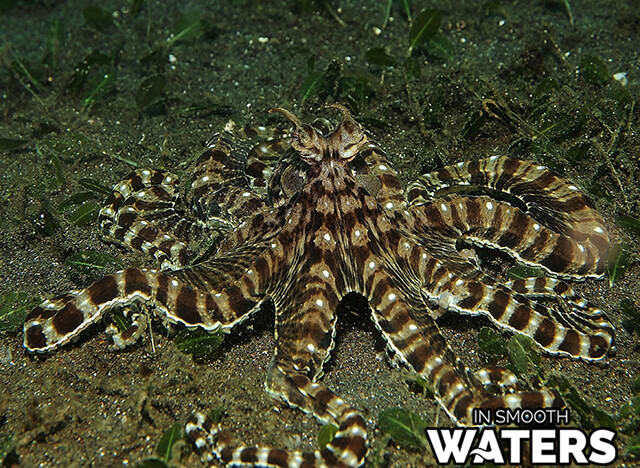
Some top camouflage fish in the ocean hide themselves using the art of impersonation. The mimic octopus hides from its enemies by transforming its flexible body to look like more ferocious creatures.
Some animals a mimic octopus can make itself look like include poisonous soles, the lionfish, and venomous sea snakes.
The above three sea creatures all have one thing in common: they’re poisonous. So, while the mimic octopus is relatively vulnerable on its own and doesn’t have any real poison to use, it can flex its shape to scare off predators who think otherwise.
A Couple More Masters of Disguise Worth Mentioning
It’s hard to believe what our eyes can’t see, but the fish we’ve talked about today are some of the most well-hidden creatures in the ocean. Of course, there are several other fish who can camouflage themselves who simply didn’t make our list of fish that camouflage. In fact, check out a few honorable mentions we thought we’d show you:
- Painted Frogfish
- Lionfish
- Scorpionfish
Through natural camouflage, the ability to change colors, and unique appearances, these fish all have highly impressive, astounding, and even beautiful features that allow them to continue the circle of sea life.

